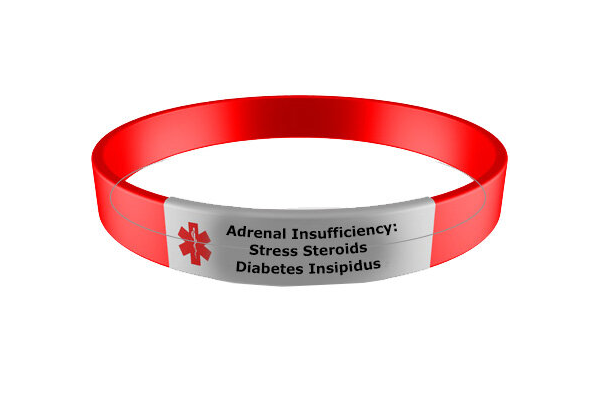-
Always have a simple, 1-page emergency letter to refer back to with contact information for the usual endocrine team.
-
Don’t rely on a separate emergency letter alone. Include the most actionable information on the ID bracelet, and avoid abbreviations if possible, since they are not universally recognized.
What to Include
For the most common panyhypopituitarism conditions that need to be conveyed to an emergency responder, the formulation should read as follows:
Adrenal Insufficiency: Stress Steroids
Diabetes Insipidus *Vasopressin Deficiency
*Please Note:
There is currently a global effort to rename diabetes insipidus to arginine vasopressin deficiency (AVP-D). In the United States, the diagnosis code (ICD-10) remains the original name of diabetes insipidus and is what is still recognized in emergency departments. This practice may change in the future but, for now, we will continue the recommendation to use the wording of diabetes insipidus but include vasopressin deficiency if space allows.
Additional information, if needed would include (if applicable):
-
Allergies (eg: Tree Nut)
-
Shunt Type
-
Other “key” problems which may include hypoglycemia, seizure d/o, anti-coagulants, etc. Get doctor feedback on which are relevant here, no need to list all, just the ones that may really need action in the field or immediately in the ER.
According to Dr. McCormack, “The rest of panhypopituitarism is less relevant immediately, and for sure does not need to be on a medic-alert (e.g., hypothyroid, GH deficiency are not needed). Since panhypopituitarism takes up a lot of room, if you can fit in the adrenal insufficiency & diabetes insipidus as those obviate the need to list panhypopituitarism.”
Resources
Download a patient information form to fill out and have on hand.
Download a wallet size card for adrenal insufficiency.
Video: Emergency Stress Dosing for Adrenal Insufficiency FAQs and Step-by-Step Tutorial

